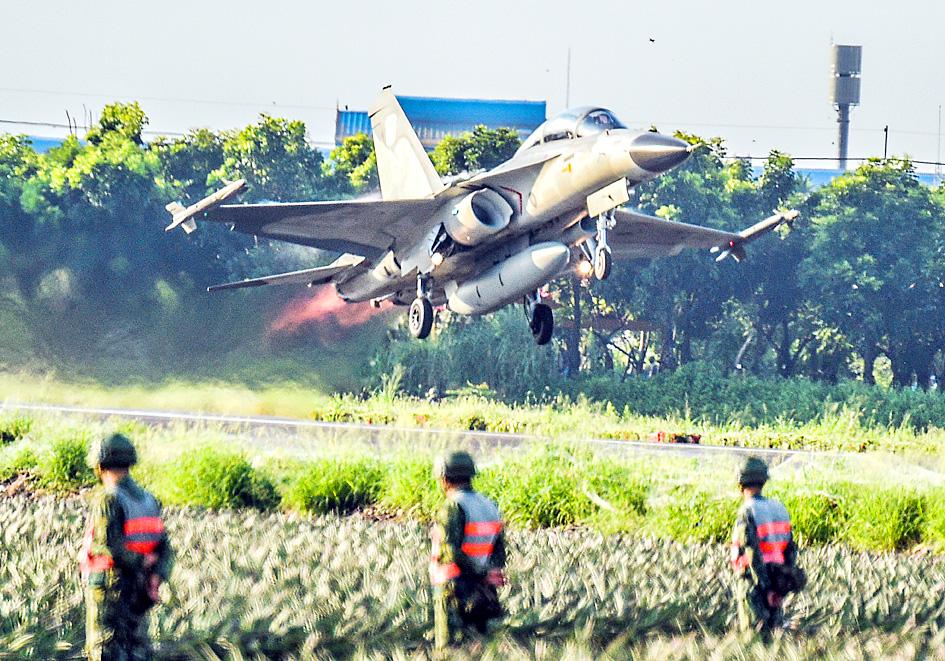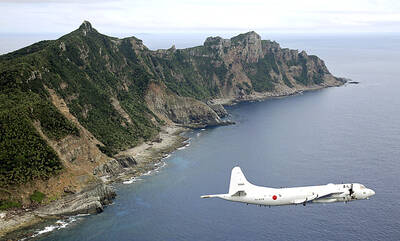The government should build more contingency runways to be used in the event of a Chinese attack on air force bases, Democratic Progressive Party Legislator Tsai Shih-ying (蔡適應) said on Saturday.
The annual Han Kuang military exercises, which ended on Friday, included an aircraft takeoff and landing exercise on a public road to test the military’s ability to adapt if air force runways are destroyed.
However, the exercises highlighted the lack of such contingency runways on the east coast of Taiwan proper, he said.

Photo: Chang Chung-yi, Taipei Times
“On the west coast there are lots of highways that are suitable for the purpose, but on the east coast there are only the bases and public airports in Hualien and Taitung counties,” he said.
With Chinese military aggression toward Taiwan on the rise over the past few years, members of the military and the public have been discussing the possibility of building more contingency runways on the east coast, he said.
Contingency runways on the west coast are all within reach of Chinese missiles, a miltiary official said yesterday, speaking on condition of anonymity.
Therefore, additional runways along the east coast in locations that are obstructed by mountains could prove invaluable in the event of an attack, they said.
The government could consider building a runway in a place like Taitung County’s Luye Township (鹿野), where there is a straight section of land for about 14.5km, they said, adding that military aircraft need only about 2km of runway to take off, so it would be more than enough space.
Chang Yan-ting (張延廷), a retired air marshal and adjunct professor at National Defense University, echoed concerns about the lack of contingency runways on the east coast, saying the area is strategically important and should be better protected.
Su Tzu-yun (蘇紫雲), a researcher at the Institute for National Defense and Security Research, said that more runways on the east coast would help mitigate some of the risk of a missile attack from China, and help bolster the nation’s defenses.

MISINFORMATION: The generated content tends to adopt China’s official stance, such as ‘Taiwan is currently governed by the Chinese central government,’ the NSB said Five China-developed artificial intelligence (AI) language models exhibit cybersecurity risks and content biases, an inspection conducted by the National Security Bureau (NSB) showed. The five AI tools are: DeepSeek, Doubao (豆包), Yiyan (文心一言), Tongyi (通義千問) and Yuanbao (騰訊元寶), the bureau said, advising people to remain vigilant to protect personal data privacy and corporate business secrets. The NSB said it, in accordance with the National Intelligence Services Act (國家情報工作法), has reviewed international cybersecurity reports and intelligence, and coordinated with the Ministry of Justice Investigation Bureau and the National Police Agency’s Criminal Investigation Bureau to conduct an inspection of China-made AI language

LIMITS: While China increases military pressure on Taiwan and expands its use of cognitive warfare, it is unwilling to target tech supply chains, the report said US and Taiwan military officials have warned that the Chinese People’s Liberation Army (PLA) could implement a blockade within “a matter of hours” and need only “minimal conversion time” prior to an attack on Taiwan, a report released on Tuesday by the US Senate’s China Economic and Security Review Commission said. “While there is no indication that China is planning an imminent attack, the United States and its allies and partners can no longer assume that a Taiwan contingency is a distant possibility for which they would have ample time to prepare,” it said. The commission made the comments in its annual

‘TROUBLEMAKER’: Most countries believe that it is China — rather than Taiwan — that is undermining regional peace and stability with its coercive tactics, the president said China should restrain itself and refrain from being a troublemaker that sabotages peace and stability in the Indo-Pacific region, President William Lai (賴清德) said yesterday. Lai made the remarks after China Coast Guard vessels sailed into disputed waters off the Senkaku Islands — known as the Diaoyutai Islands (釣魚台) in Taiwan — following a remark Japanese Prime Minister Sanae Takaichi made regarding Taiwan. Takaichi during a parliamentary session on Nov. 7 said that a “Taiwan contingency” involving a Chinese naval blockade could qualify as a “survival-threatening situation” for Japan, and trigger Tokyo’s deployment of its military for defense. Asked about the escalating tensions

DISPUTE: A Chinese official prompted a formal protest from Tokyo by saying that ‘the dirty head that sticks itself out must be cut off,’ after Takaichi’s Taiwan remarks Four armed China Coast Guard vessels yesterday morning sailed through disputed waters controlled by Japan, amid a diplomatic spat following Japanese Prime Minister Sanae Takaichi’s comments on Taiwan. The four ships sailed around the Senkaku Islands — known as the Diaoyutai Islands (釣魚台) to Taiwan, and which Taiwan and China also claim — on Saturday before entering Japanese waters yesterday and left, the Japan Coast Guard said. The China Coast Guard said in a statement that it carried out a “rights enforcement patrol” through the waters and that it was a lawful operation. As of the end of last month,